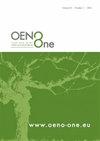探究葡萄品种在季节环境变异影响下的关键生理特性
IF 2.2
3区 农林科学
Q3 FOOD SCIENCE & TECHNOLOGY
引用次数: 1
摘要
季节性气候变化是全球许多葡萄种植区面临的一个关键挑战,影响了葡萄的酚学、生长、生理反应和收获产量。不利的气候条件损害了植物的生理过程,如葡萄叶片中的叶绿素积累、气体交换和光合作用。关键是要了解葡萄品种在关键酚期和不同环境条件下的复杂生理行为。本研究采用析因实验装置(地点×年份×品种×表型阶段),对波特瓦尔地区不同环境条件下4个葡萄品种在关键生长阶段的气体交换、叶绿素含量和水分利用效率等关键生理过程进行了评价。在两个地点(伊斯兰堡和查克瓦尔)连续两个年份(2019年和2020年),记录了食用葡萄品种在5叶期、盛花期、浆果期、白藜芦醇期和收获期的生理反应。结果表明,较冷的伊斯兰堡的平均光合活性比查克瓦尔高30.7%,蒸腾速率和水分利用效率分别高10.4%和28.6%。同样,与2019年相比,2020年较冷年份的光合活性高出12%,WUE高出13%。葡萄藤的生理活性也因品种而异;例如,Sugraone比Kings Ruby多12%的叶绿素和30%的光合活性。同样,在浆果结实期记录到较高的光合活性和蒸腾速率,而WUE在开花附近达到峰值。对前两个主要成分的双批次分析也表明,苏格龙是一个反应强烈、生理有效的品种。本研究结果将有助于更好地评估季节变异对葡萄生理性能的影响,并确定具有更高光合潜力和WUE的基因型。它还可以帮助制定葡萄园管理战略,以更好地适应不同的环境条件。本文章由计算机程序翻译,如有差异,请以英文原文为准。
Exploring key physiological attributes of grapevine cultivars under the influence of seasonal environmental variability
Seasonal climatic variability is a key challenge in many grape-growing regions across the globe, affecting phenology, growth, physiological responses, and yield at harvest. Unfavourable climatic conditions impair the plant's physiological processes, such as chlorophyll accumulation, gas exchange and photosynthesis in grapevine leaves. It is critical to unlock the complex physiological behaviour of grapevine cultivars at key phenological stages and under varying environmental conditions. The present study was designed to evaluate the key physiological processes, such as gas exchange, chlorophyll contents and water use efficiency (WUE), of four table grape cultivars at key growth stages under varying environmental conditions of the Pothwar region, in a factorial experimental set up (Location× Year × Cultivar × Phenological stage). The physiological responses of the table grape cultivars were recorded at the 5-leaf stage, full bloom, berry set, veraison and harvest during two consecutive vintages (2019 and 2020) in two locations (Islamabad and Chakwal). The results show that the mean photosynthetic activity in colder Islamabad was 30.7 % higher than in Chakwal, and the transpiration rate and WUE were 10.4 % and 28.6 % higher. Similarly, 12 % higher photosynthetic activity, with 13 % more WUE, was observed in the colder vintage of 2020 compared to that of 2019. The vine physiological activity also varied among cultivars; for example, cv. Sugraone was found to have 12 % more chlorophyll and 30 % higher photosynthetic activity than cv. Kings Ruby. Similarly, higher photosynthetic activity and transpiration rates were recorded at the berry set stage, while WUE peaked near blooming. The biplot analysis for the first two principal components also showed cv. Sugraone to be a highly responsive and physiologically efficient cultivar. The findings of the present research will help to better assess the effect of seasonal variability on vine physiological performance and to identify genotypes with higher photosynthetic potential and WUE. It could also assist in devising vineyard management strategies to better adapt to varying environmental conditions.
求助全文
通过发布文献求助,成功后即可免费获取论文全文。
去求助
来源期刊

OENO One
Agricultural and Biological Sciences-Food Science
CiteScore
4.40
自引率
13.80%
发文量
85
审稿时长
13 weeks
期刊介绍:
OENO One is a peer-reviewed journal that publishes original research, reviews, mini-reviews, short communications, perspectives and spotlights in the areas of viticulture, grapevine physiology, genomics and genetics, oenology, winemaking technology and processes, wine chemistry and quality, analytical chemistry, microbiology, sensory and consumer sciences, safety and health. OENO One belongs to the International Viticulture and Enology Society - IVES, an academic association dedicated to viticulture and enology.
 求助内容:
求助内容: 应助结果提醒方式:
应助结果提醒方式:


